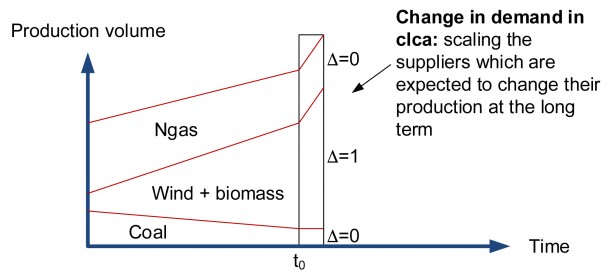Why a ‘shrinking’ technology will never dominate the marginal
May 10, 2016 by Jannick Schmidt
– The case of electricity mixes in consequential LCA
Have you ever doubted what to include in your technology mixes? What happens when a technology is dominating the mix of today, but we know that the technology will be phased out and reduced in the future?
To an extent the answer depends on your study. But the studies we perform are for decision support, where our clients need to understand the environmental impacts of a change in demand for the product under study. For such studies we need a consequential approach – a modelling approach in which activities in a product system are linked so that all activities that are expected to change are included.
At the core of the consequential LCA are the marginal suppliers. They are defined as the ones being installed as a consequence of a change in demand (in increasing and stable markets, which is the general case for most products). You can read more details about marginal suppliers at www.consequential-lca.org.
Here, let us look at a concrete example. In our Energy Club we developed consequential LCIs on electricity for more than 20 different countries and regions (contact us for availability of these data). In these LCIs we base the identification of the marginal suppliers on the above reasoning. So the marginal electricity suppliers are those that are predicted to increase their installed capacity. The only exception is when they are constrained. That could be by a dependence on an input of a waste or by‐product or if the increase is fixed by legislation or other factors not related to changes in demand. Technologies with declining trends are not regarded as being part of the marginal.
For instance, we found that the suppliers in Denmark that are predicted to increase capacity are wind and biomass; while coal is a decreasing (old) technology. This means that wind and biomass are marginal, while coal is not part of the marginal. See the figure below.

Any timing of the phasing out of technologies, such as coal, can provide a little flexibility and thereby make it a small part of the marginal, but never a significant part. Situations with flexibility could be:
‐ When there is a significant amount of overcapacity of the old technology
‐ In very short periods of time, to solve short‐term (quarters of years to entire years) need for capacity.
But still the shrinking technology will never dominate the marginal. This is because the timing of the phase out of old technologies is predominantly determined by other factors than changes in demand. These other factors include the life time/replacement rate of the technology as well as the economic performance compared to the new technologies that are installed.
Reference:
Muñoz I, Schmidt J H, de Saxcé M, Dalgaard R, Merciai S (2015), Inventory of country specific electricity in LCA ‐ consequential scenarios. Version 3.0. Report of the 2.‐0 LCA Energy Club. 2.-0 LCA consultants, Aalborg